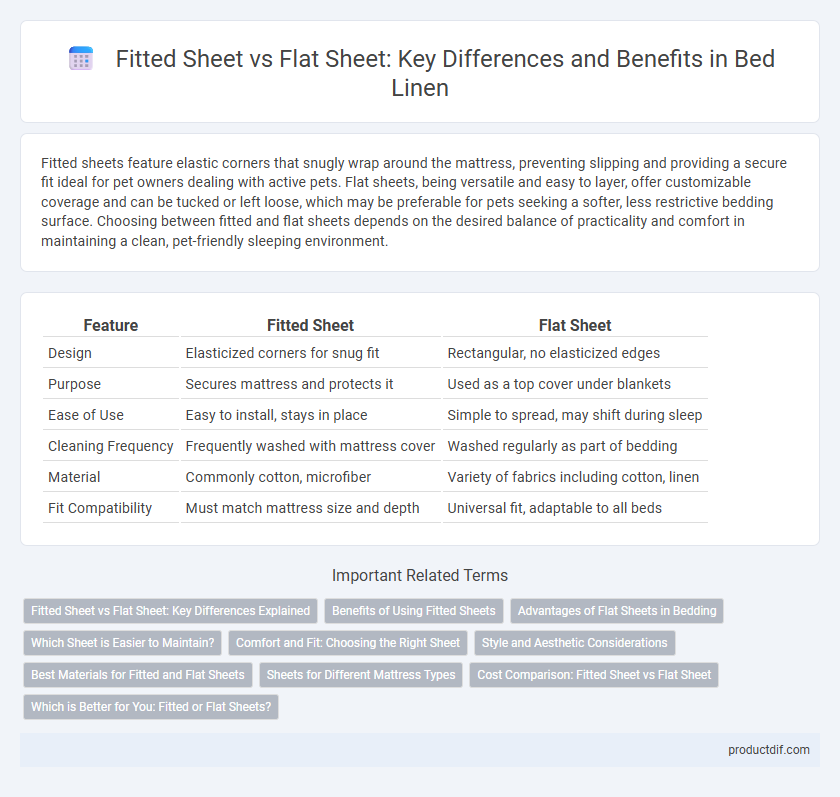Fitted sheets feature elastic corners that snugly wrap around the mattress, preventing slipping and providing a secure fit ideal for pet owners dealing with active pets. Flat sheets, being versatile and easy to layer, offer customizable coverage and can be tucked or left loose, which may be preferable for pets seeking a softer, less restrictive bedding surface. Choosing between fitted and flat sheets depends on the desired balance of practicality and comfort in maintaining a clean, pet-friendly sleeping environment.
Table of Comparison
| Feature | Fitted Sheet | Flat Sheet |
|---|---|---|
| Design | Elasticized corners for snug fit | Rectangular, no elasticized edges |
| Purpose | Secures mattress and protects it | Used as a top cover under blankets |
| Ease of Use | Easy to install, stays in place | Simple to spread, may shift during sleep |
| Cleaning Frequency | Frequently washed with mattress cover | Washed regularly as part of bedding |
| Material | Commonly cotton, microfiber | Variety of fabrics including cotton, linen |
| Fit Compatibility | Must match mattress size and depth | Universal fit, adaptable to all beds |
Fitted Sheet vs Flat Sheet: Key Differences Explained
Fitted sheets feature elasticized corners designed to snugly wrap around a mattress, ensuring a secure fit and preventing slipping during sleep. Flat sheets are rectangular, lying loosely over the bed and offering versatility as both a top sheet or an additional layer for warmth. Understanding the distinction in design and function between fitted and flat sheets helps optimize bedding choices for comfort, maintenance, and aesthetic preferences.
Benefits of Using Fitted Sheets
Fitted sheets provide a snug and secure fit around the mattress, preventing slipping and bunching for a smooth sleeping surface. Their elasticized corners save time during bed-making and maintain the sheet's position even with movement during sleep. This ensures enhanced comfort and a tidier bedroom appearance compared to flat sheets.
Advantages of Flat Sheets in Bedding
Flat sheets offer versatile bedding options by providing an extra layer of comfort and protection between the sleeper and blankets, which helps keep blankets cleaner for longer periods. They are easier to adjust and tuck, allowing for better temperature regulation and added breathability during sleep. Flat sheets also simplify washing and drying, as they tend to wrinkle less and maintain their shape better compared to fitted sheets.
Which Sheet is Easier to Maintain?
Fitted sheets are generally easier to maintain due to their elasticized edges that keep them securely in place, preventing constant readjustment during sleep. Flat sheets require frequent tucking and smoothing to avoid bunching, making them more high-maintenance. Both sheets benefit from regular washing, but fitted sheets demand less effort for daily upkeep and bed making.
Comfort and Fit: Choosing the Right Sheet
Fitted sheets offer a snug fit with elastic corners that securely wrap around the mattress, preventing slipping and providing consistent comfort throughout the night. Flat sheets provide versatility, allowing easy adjustment and layering, which can enhance breathability and temperature control. Selecting the right sheet depends on personal preference for stability or adaptability, ensuring optimal comfort tailored to your sleeping habits.
Style and Aesthetic Considerations
Fitted sheets offer a sleek, tailored look by hugging the mattress corners, creating a smooth and wrinkle-free surface that enhances bedroom aesthetics. Flat sheets provide versatile styling options, allowing users to fold or tuck them creatively to match various decor themes and personal preferences. Choosing between fitted and flat sheets depends on the desired visual appeal and the balance between convenience and customizable bed presentation.
Best Materials for Fitted and Flat Sheets
Egyptian cotton ranks among the best materials for fitted and flat sheets due to its long fibers that create a soft, durable, and breathable fabric. Percale weave, known for its crisp feel and breathability, is ideal for flat sheets that stay cool, while sateen weave offers a silky smooth texture preferred in fitted sheets for a snug, luxurious fit. Linen fabric, valued for its moisture-wicking properties and durability, is a top choice for both fitted and flat sheets in warmer climates.
Sheets for Different Mattress Types
Fitted sheets are designed with elastic edges to snugly fit mattresses of various thicknesses, providing a secure and wrinkle-free surface ideal for deep or pillow-top mattresses. Flat sheets offer versatility by fitting any mattress size and type, making them a preferred choice for adjustable beds or mattresses with unconventional dimensions. Choosing between fitted and flat sheets depends on the mattress design, ensuring optimal comfort and protection for different mattress heights and firmness levels.
Cost Comparison: Fitted Sheet vs Flat Sheet
Fitted sheets typically cost more than flat sheets due to their elastic edges and tailored design, which require more precise manufacturing. Flat sheets are generally less expensive, made from simpler, rectangular fabric without elastic, making them more budget-friendly. Consumers seeking cost efficiency often choose flat sheets for their lower price point and versatile use.
Which is Better for You: Fitted or Flat Sheets?
Fitted sheets offer a snug, secure fit with elasticized corners that prevent slipping, making them ideal for restless sleepers or those seeking low-maintenance bedding. Flat sheets provide versatility in layering and ease of washing, allowing users to adjust coverage and temperature control throughout the night. Choosing between fitted and flat sheets depends on personal preference, mattress size, and desired convenience in bed-making and upkeep.
Fitted sheet vs Flat sheet Infographic

 productdif.com
productdif.com